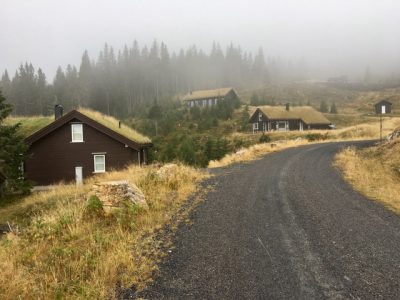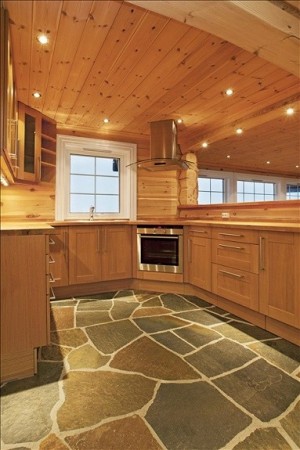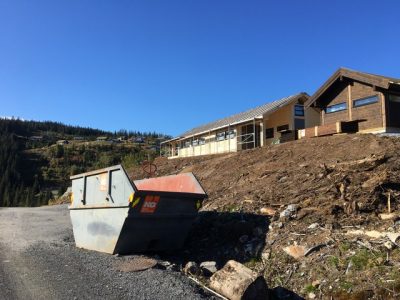Norway’s autumn holidays ended over the weekend with more record sales of the traditional holiday home known as a “hytte.” That’s not to be confused with a “hut,” as large new developments in the hills and mountains resemble housing tracts with prices running as high as NOK 30 million (USD 3.6 million) or even more.

A Norwegian hytte used to be a simple log cabin in the mountains or woods, or a modest coastal residence, most often lacking electricity and with water coming from melted snow or a well. The infamous utedo (outdoor toilet) was located well away from the dwelling unit.
Now the vast majority contain all the comforts of home, sometimes even moreso. New studies have shown how some families put much more energy and investment into their hytte than in their primary residence. Norway’s strong economy has enabled that, not least as the country’s oil wealth has continued to fuel household budgets. Some “hytter” have evolved into luxury palaces: A real estate broker in the popular Beitostølen area of Valdres could confirm to newspaper Dagens Næringsliv (DN) during the weekend that another record had been set: Somebody paid “around” NOK 29.5 million for a 322-square-meter “hytte” with seven bedrooms, four bathrooms and a separate “spa section.”
Hytter (plural form) have long been part of the national heritage in Norway, and are even mentioned in Norway’s national anthem. Some equate them to “a family museum” as they’ve passed through generations. Standards have been rising and the hytte market booming for years, but never moreso since the Corona crisis began last year. When a short and highly controversial ban on visiting even one’s own hytte finally ended, demand and prices started soaring just before the summer of last year.
The pandemic prodded affluent Norwegians who’d normally travel abroad for their holidays to rediscover their own country as a holiday destination. Many also quickly experienced the risk of having holiday homes in the south of France or Spain, or even just over the border in Sweden, to which they could no longer travel. Suddenly the Norwegian coast and the mountains became a lot more interesting. Home offices could also become “hytte offices,” with lots of people able to do their work online and pop out for a ski trip or hike during lunch.
It’s all led to double-digit price hikes that have pushed the average price of a mountain hytte (located at an elevation over 800 meters and therefore most likely to have snow for skiing) to NOK 3.4 million so far this year, according to senior analyst Carl Christian Mathiesen at Oslo-based Prognosesenteret. It’s an independent firm specializing in market analysis of the construction and real estate industries.
“That’s 10 percent higher than the same period last year,” Mathiesen told DN just before the autumn holidays began. “The average price per square meter was 15 percent higher, which gives a better measure of price growth.” The numbers include sales of both new and used hytter. Despite all the new hytte construction projects both planned or underway, resales of existing hytter still make up 85 percent of the total market.

Prices are expected to keep rising, since there’s still more demand than supply. Rising costs of building materials may also boost the prices listed by developers. That hasn’t seemed to bother buyers, even during the Corona crisis, with one real estate brokerage firm active in Hemsedal, Hallingdal and Valdres reporting a 35 percent increase in hytte sales so far this year.
Last year was super-strong, too. One “luxury hytte” at Kvitfjell (site of the men’s downhill in the 1994 Winter Olympics) went on the market on a Saturday last December and sold on Monday for NOK 2 million over its asking price of NOK 25 million plus taxes. Its online ad had attracted around 20,000 “clicks” and even the broker was impressed: “I’d expected it would sell quickly, but not that quickly,” he told DN at the time.
By April, nine out of 10 hytter on the market had sold for over their asking prices. State statistics bureau SSB reported that more than 3,600 holiday homes (both hytter and condominiums) were sold during the first quarter of this year, up a whopping 49 percent over the first quarter of 2020.
In the spring, brokers could still report brisk sales for summer homes near the sea, with prices up 15-20 percent. Henning Lauridsen, head of the real estate brokers’ association Eiendom Norge, told newspaper Aftenposten in June that “we have never seen such quick turnover in the holiday home market.” Prices for hytter in the mountains were up 16.5 percent during the first half of the year, 12.5 percent for “inland” hytter in areas at lower elevation and 6.4 percent for hytter along the coast.
Market ‘exploding’
There was no let-up during the recent autumn holidays, on the contrary the market was “exploding” already in August. Sales of summer homes along the coast have also been brisk but the biggest growth has been in the mountains. “Sales have never been so good, they’re just fantastic,” broker Petter Bikrem in Trysil told DN in mid-August, when he and others think buyers were trying to beat the autumn sales season. “It’s an all-time high for me.”
By the time Norway annual hytte exposition, a trade fair for the hytte builders and suppliers, was held late last month, organizers were calling the market “crazy.” Organizers who’d had to cancel last year’s displays of everything from hytte lots and furniture to toilet systems and hytter themselves claim there are still lots of new hytte developments “zoned and waiting for buyers.”

That in itself continues to raise alarm. Many hytte owners are skeptical about ongoing projects that are tearing down forests and bringing more roads and activity into areas that once were quiet and scenic. Environmental organizations have protested for years over how hytte-building is destroying the nature and adding to the climate crisis. Now some politicians are claiming that the hytte boom is out of control.
They include Members of Parliament from the Socialist Left Party (SV) and the Greens. Even the non-socialist Venstre Party’s former minister of the environment, Sveinung Rotevatn, proposed much higher fees for developers who tear down trees and build roads and infrastructure in previously untouched areas. “There should be a price for building in vulnerable nature,” Rotevatn said last fall, when debate was also flying over hytte construction projects.
He won support from SV but then came the Corona crisis and the proposals stalled. The UN itself has warned, though, that loss of nature is as big a threat as climate change and human activity. Hytte developments tend to pose both. Others including professors and legal experts are proposing the equivalent of a marka-grense like the border around the forests surrounding Oslo where new construction is now banned. “It’s the only way to stop this bit-by-bit development of the wilderness,” argued Professor Vigdis Vandvik of the University of Bergen in a commentary in DN last winter.
Hytter likened to ‘parasites’
Other critics include Gisle Løkken, president of Norway’s national architects’ federation, who has called all the new hytter popping up on Norwegian mountainsides “parasites that undermine the ecological balance we all depend upon.” Local governments are being called upon to halt all the tree-cutting, movement of land mass, hacking into rock and introduction of thousands of people into what once were open natural areas.
Even the national hytte association Norsk Hyttelag has questioned how many hytter Norway should make room for. “We wish all new hytte owners welcome, but also see the challenges of the enormous growth,” wrote the group leader, Audun Bringsvor, in the association’s own membership bulletin. The popular Sjusjøen area between Hamar and Lillehammer already has more than 7,000 hytter with more planned. Many are protesting new developments, also at Flå in Hallingdal, at Vinje in Telemark and at Trysil, to name a few places.

The Greens Party wants to limit hytte building at a national level, to prevent local municipalities (keen on the jobs and tax revenues hytter can provide) from ruining scenic areas and adding to emmissions as hytte owners drive to and from their holiday homes all through the year. The Center Party, now part of the government, is often quick to defend hytte projects because of the economic development they bring to rural areas. Even within the farmer-friendly Center, however, conflicts are rising, most recently over how fencing isn’t always allowed around hytter, leading to cows and sheep grazing and defecating just outside the front door.
The leader of Trysil’s tourism marketing organization Destination Trysil claimed in Aftenposten last spring that over the past 50 years, 1,500 jobs lost in the timber industry have been replaced by 1,500 jobs in the travel industry. Hytter and hotels “uphold the community, its population and services offered.” Hytte investment is “crucial” for the local economy and its tax base, claiming that 83 percent of the local population is positive towards tourism development. There often have been conflicts between “hytte folk” and “local folk” in Norway over the years, but during the Corona ban on hytte visits, many local communities including prosperous Hemseldal suffered greatly from the loss of grocery, restaurant and other business revenues right during the important Easter holiday period.
New proposed tax value assessments of secondary homes and hytter may dampen the hytte boom, if only because hytte ownership will soon become even more expensive. Many local communities have already sharply raised property tax assessments and now Norway’s new left-center government wants to appraise holiday homes in the same way as primary residences when forming the base for Norway’s much-debated tax on personal net worth (formueskatt/fortune tax). Values today are based on historic building costs, raised at irregular intervals. Now the finance ministry wants to apply the same principles that set taxable value at 25-30 percent of market value. The new government may go along with another proposal to raise that to 35-40 percent for hytter.
The so-called “dessert generation” of today that’s reaping the benefits of Norway’s nation-building after World War II “aren’t building the country, they building hytter,” argued civil economist Andreas Landsverk Farberg in DN last spring. “They should pay a larger share of their fortunes, and not just pass it on to their heirs,” he wrote.
Not everyone can afford hytter anymore, with some young familes opting to rent them out for fixed periods when they’re not using them. Others are rejecting the thought of buying a brand new hytte with all modern conveniences but also neighbours just as close as in the city.
Ongoing search for the ‘charm’ of a hytte
“The new hytte projects are like a housing development where we wouldn’t have the ‘hytte feeling’ we want,” Sigfred Nomell Havdahl told DN last week. He’s in the market, along with his wife and family, for a modest, older hytte that they can fix up and make “our own.” It’s still possible to find hytter built in the 1970s and 1980s for under NOK 2 million, stressed newspaper VG in a large feature on the hytte market.
“It’s okay to have some other hytter around us, but only if they’re spread out,” Havdahl. “Brand new hytter don’t have the same charm, either.” They were debating buying a place in Eggedal to which couldn’t drive right up to the property. It had electricity, but water had to be fetched from a well outside. There are lots of prepared ski trails in the area in the winter, however, and the 68-square-meter hytte was on the market for NOK 800,000 (USD 92,000), less than a fourth of the price for a new modest hytte.
“If you’re willing to make some improvements yourself, you can also enjoy a big gain on the investment in an older hytte,” broker Kari-Beate Myhre told DN. “It also offers a good possibility to break into the market.”
newsinenglish.no/Nina Berglund

